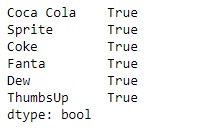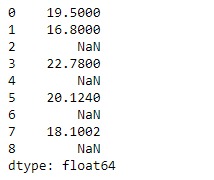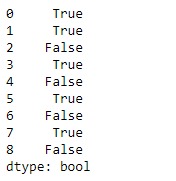Pandas 係列是帶有軸標簽的一維ndarray。標簽不必是唯一的,但必須是可哈希的類型。該對象同時支持基於整數和基於標簽的索引,並提供了許多方法來執行涉及索引的操作。
Pandas Series.notnull()函數檢測現有(非缺失)值。此函數返回一個布爾對象,其大小與對象相同,指示值是否缺少值。非缺失值將映射為True。空字符串”或numpy.inf不視為NA值(除非設置了pandas.options.mode.use_inf_as_na = True)。 NA值(例如None或numpy.NaN)被映射為False值。
用法: Series.notnull()
參數:沒有
返回:係列
範例1:采用Series.notnull()函數檢測給定係列對象中的所有非缺失值。
# importing pandas as pd
import pandas as pd
# Creating the Series
sr = pd.Series([10, 25, 3, 11, 24, 6])
# Create the Index
index_ = ['Coca Cola', 'Sprite', 'Coke', 'Fanta', 'Dew', 'ThumbsUp']
# set the index
sr.index = index_
# Print the series
print(sr)輸出:

現在我們將使用Series.notnull()函數檢測係列對象中的非缺失值。
# detect non-missing value
result = sr.notnull()
# Print the result
print(result)輸出:

正如我們在輸出中看到的,Series.notnull()函數已返回布爾對象。True表示沒有缺少相應的值。Falsevalue表示缺少該值。在本係列中,所有值均為True,因為沒有缺失值。
範例2:采用Series.notnull()函數檢測給定係列對象中的所有非缺失值。
# importing pandas as pd
import pandas as pd
# Creating the Series
sr = pd.Series([19.5, 16.8, None, 22.78, None, 20.124, None, 18.1002, None])
# Print the series
print(sr)輸出:

現在我們將使用Series.notnull()函數檢測係列對象中的非缺失值。
# detect non-missing value
result = sr.notnull()
# Print the result
print(result)輸出:

正如我們在輸出中看到的,Series.notnull()函數已返回布爾對象。True表示沒有缺少相應的值。Falsevalue表示缺少該值。
相關用法
- Python pandas.map()用法及代碼示例
- Python Pandas Series.str.len()用法及代碼示例
- Python Pandas.factorize()用法及代碼示例
- Python Pandas TimedeltaIndex.name用法及代碼示例
- Python Pandas dataframe.ne()用法及代碼示例
- Python Pandas Series.between()用法及代碼示例
- Python Pandas DataFrame.where()用法及代碼示例
- Python Pandas Series.add()用法及代碼示例
- Python Pandas.pivot_table()用法及代碼示例
- Python Pandas Series.mod()用法及代碼示例
- Python Pandas Dataframe.at[ ]用法及代碼示例
- Python Pandas Dataframe.iat[ ]用法及代碼示例
- Python Pandas.pivot()用法及代碼示例
- Python Pandas dataframe.mul()用法及代碼示例
- Python Pandas.melt()用法及代碼示例
注:本文由純淨天空篩選整理自Shubham__Ranjan大神的英文原創作品 Python | Pandas Series.notnull()。非經特殊聲明,原始代碼版權歸原作者所有,本譯文未經允許或授權,請勿轉載或複製。
